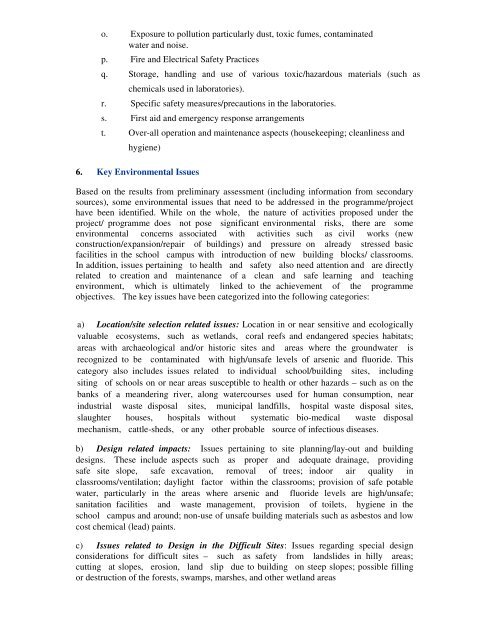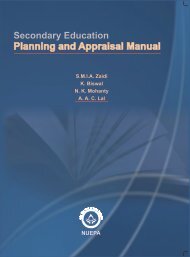Download File
Download File
Download File
Create successful ePaper yourself
Turn your PDF publications into a flip-book with our unique Google optimized e-Paper software.
o. Exposure to pollution particularly dust, toxic fumes, contaminated<br />
water and noise.<br />
p. Fire and Electrical Safety Practices<br />
q. Storage, handling and use of various toxic/hazardous materials (such as<br />
chemicals used in laboratories).<br />
r. Specific safety measures/precautions in the laboratories.<br />
s. First aid and emergency response arrangements<br />
t. Over-all operation and maintenance aspects (housekeeping; cleanliness and<br />
hygiene)<br />
6. Key Environmental Issues<br />
Based on the results from preliminary assessment (including information from secondary<br />
sources), some environmental issues that need to be addressed in the programme/project<br />
have been identified. While on the whole, the nature of activities proposed under the<br />
project/ programme does not pose significant environmental risks, there are some<br />
environmental concerns associated with activities such as civil works (new<br />
construction/expansion/repair of buildings) and pressure on already stressed basic<br />
facilities in the school campus with introduction of new building blocks/ classrooms.<br />
In addition, issues pertaining to health and safety also need attention and are directly<br />
related to creation and maintenance of a clean and safe learning and teaching<br />
environment, which is ultimately linked to the achievement of the programme<br />
objectives. The key issues have been categorized into the following categories:<br />
a) Location/site selection related issues: Location in or near sensitive and ecologically<br />
valuable ecosystems, such as wetlands, coral reefs and endangered species habitats;<br />
areas with archaeological and/or historic sites and areas where the groundwater is<br />
recognized to be contaminated with high/unsafe levels of arsenic and fluoride. This<br />
category also includes issues related to individual school/building sites, including<br />
siting of schools on or near areas susceptible to health or other hazards – such as on the<br />
banks of a meandering river, along watercourses used for human consumption, near<br />
industrial waste disposal sites, municipal landfills, hospital waste disposal sites,<br />
slaughter houses, hospitals without systematic bio-medical waste disposal<br />
mechanism, cattle-sheds, or any other probable source of infectious diseases.<br />
b) Design related impacts: Issues pertaining to site planning/lay-out and building<br />
designs. These include aspects such as proper and adequate drainage, providing<br />
safe site slope, safe excavation, removal of trees; indoor air quality in<br />
classrooms/ventilation; daylight factor within the classrooms; provision of safe potable<br />
water, particularly in the areas where arsenic and fluoride levels are high/unsafe;<br />
sanitation facilities and waste management, provision of toilets, hygiene in the<br />
school campus and around; non-use of unsafe building materials such as asbestos and low<br />
cost chemical (lead) paints.<br />
c) Issues related to Design in the Difficult Sites: Issues regarding special design<br />
considerations for difficult sites – such as safety from landslides in hilly areas;<br />
cutting at slopes, erosion, land slip due to building on steep slopes; possible filling<br />
or destruction of the forests, swamps, marshes, and other wetland areas




